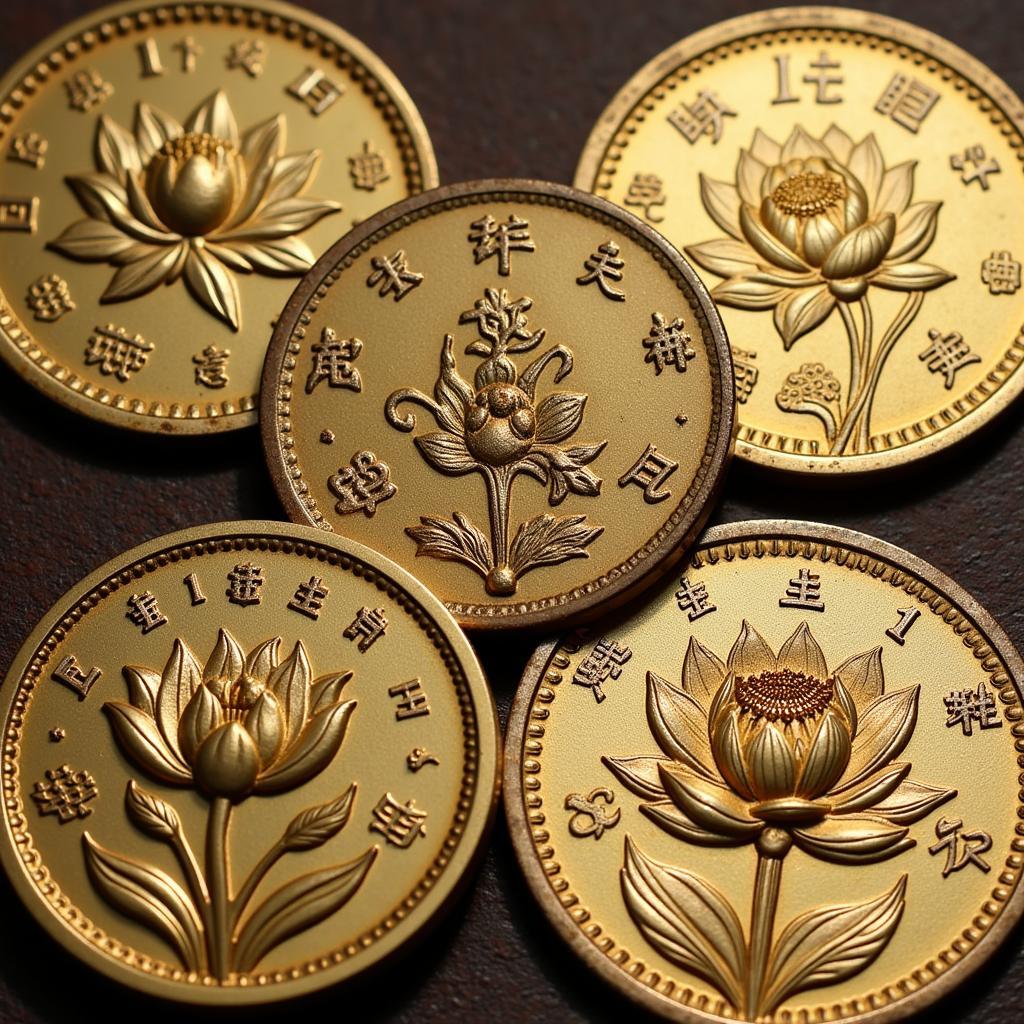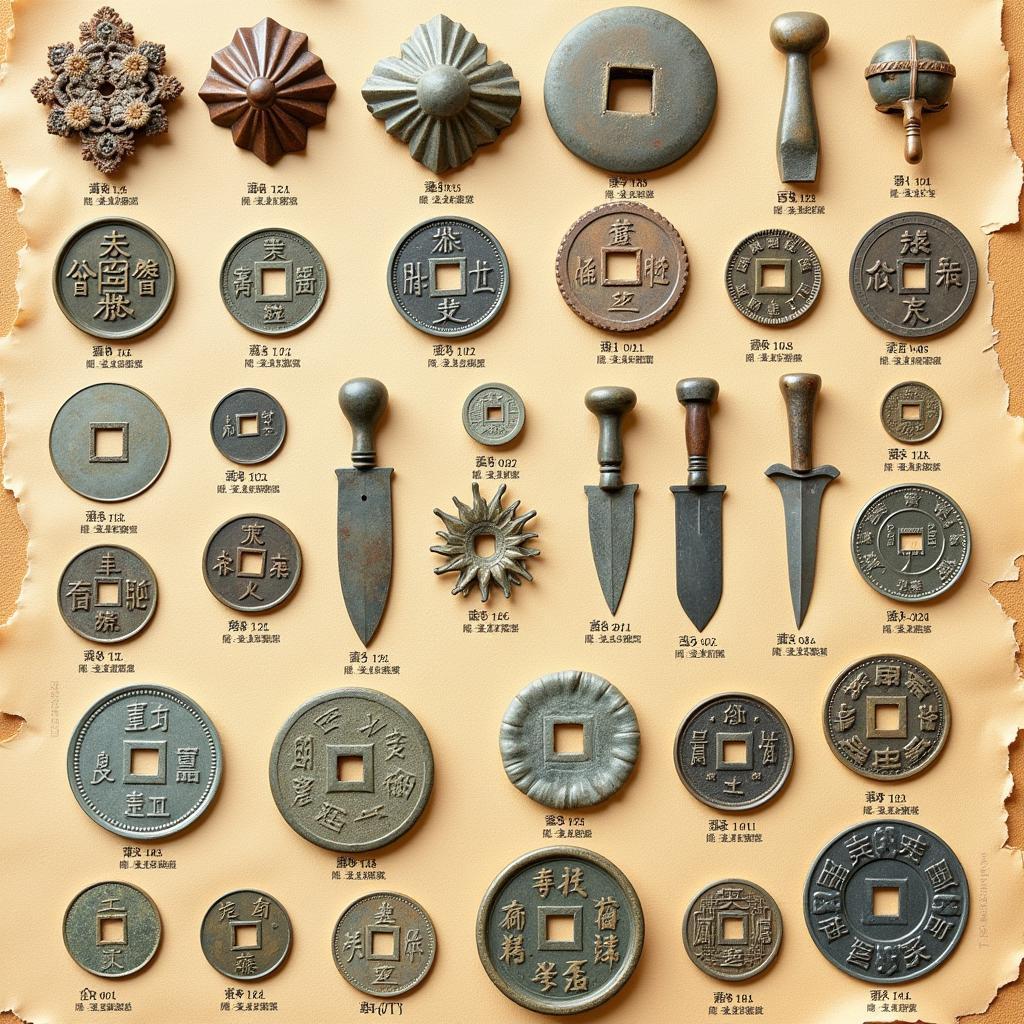Current Chinese Currency Coins are an essential part of China’s modern monetary system, representing the smaller denominations of the Renminbi (RMB), also known as the yuan (CNY). Understanding these coins is crucial for anyone interacting with the Chinese economy, whether traveling, conducting business, or simply curious about numismatics. This guide will delve into the specifics of current Chinese coins, their history, and their significance.
Exploring the Denominations of Current Chinese Currency Coins
Current Chinese currency coins come in six denominations: 1 jiao, 5 jiao, and 1 yuan. The jiao is a subunit of the yuan, with 10 jiao equaling 1 yuan. Each coin features distinct designs and compositions, making them readily identifiable. The 1 jiao coin portrays an orchid, the 5 jiao a lotus, and the 1 yuan coin depicts a chrysanthemum. These floral motifs reflect aspects of Chinese culture and symbolism.
Material Composition and Design of Chinese Coins
The metallic composition of Chinese coins has evolved over time, reflecting changes in material costs and production technologies. Currently, the 1 jiao coin is made of aluminum, while the 5 jiao and 1 yuan coins are primarily composed of nickel-plated steel. The designs on the coins, featuring national symbols and floral motifs, not only serve aesthetic purposes but also aid in identification and prevent counterfeiting.
Why are Floral Motifs Used on Current Chinese Currency Coins?
The use of floral motifs on current Chinese coins carries symbolic weight. The orchid, lotus, and chrysanthemum are deeply rooted in Chinese culture, representing virtues like resilience, purity, and longevity. These symbolic associations add cultural significance to the currency.
 Floral Symbols on Chinese Coins
Floral Symbols on Chinese Coins
The Evolution of Chinese Coinage
Chinese coinage boasts a rich history, stretching back millennia. From ancient bronze coins with square holes to the modern currency we use today, the evolution of Chinese coins reflects the country’s historical and economic transformations. The introduction of the Renminbi in 1948 marked a significant shift in Chinese monetary policy, leading to the standardization of currency across the nation.
What were the Earliest Forms of Chinese Currency?
The earliest forms of Chinese currency were not coins but rather objects like cowrie shells and tools. These gradually evolved into metal currencies, including bronze knives and spades, before eventually developing into round coins with distinctive shapes and markings.
 History of Chinese Currency
History of Chinese Currency
The Importance of Understanding Current Chinese Currency Coins
Understanding current Chinese currency coins is crucial for anyone engaging with the Chinese economy. Whether you are a traveler navigating local markets, a businessperson conducting transactions, or a numismatist exploring the world of currency, familiarizing yourself with these coins is essential for smooth and effective interactions. Recognizing the denominations, designs, and composition of these coins ensures accurate transactions and fosters a deeper appreciation for the intricacies of the Chinese monetary system.
In conclusion, current Chinese currency coins represent more than just denominations of the Renminbi; they are a reflection of China’s cultural heritage, economic development, and symbolic language. By understanding these coins, we gain valuable insights into the complexities of Chinese society and its financial landscape.
FAQ
- What is the smallest denomination of current Chinese currency coins? (1 jiao)
- What floral motif is depicted on the 1 yuan coin? (Chrysanthemum)
- What metal is the 1 jiao coin primarily made of? (Aluminum)
- When was the Renminbi introduced? (1948)
- How many jiao are in 1 yuan? (10)
- What is the symbol for the Chinese Yuan? (CNY)
- Are there any coins larger than 1 yuan in circulation? (No)
Mô tả các tình huống thường gặp câu hỏi.
- Du lịch: Khi đi du lịch Trung Quốc, việc hiểu rõ mệnh giá tiền xu giúp bạn tránh bị nhầm lẫn khi mua sắm và trả tiền.
- Giao dịch thương mại: Trong giao dịch thương mại với các đối tác Trung Quốc, việc nắm vững tiền tệ giúp đảm bảo tính chính xác và minh bạch.
- Sưu tầm tiền xu: Đối với những người sưu tầm tiền xu, tiền xu Trung Quốc là một lĩnh vực thú vị và đầy tiềm năng.
Gợi ý các câu hỏi khác, bài viết khác có trong web.
- Tỷ giá hối đoái giữa Nhân dân tệ và các loại tiền tệ khác là bao nhiêu?
- Tiền giấy Trung Quốc có những mệnh giá nào?
- Lịch sử phát triển của tiền tệ Trung Quốc như thế nào?

